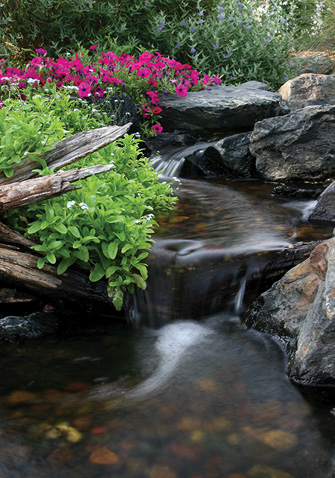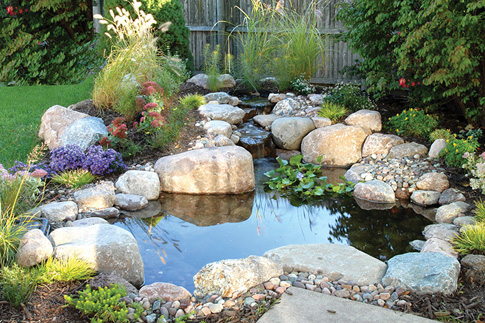With today’s busy schedules and the country’s slowly rebounding economy, more people are yearning to create outdoor living spaces that help them unwind, de-stress and reconnect with their families and nature.

Backyards around the country are being transformed into true paradises, often with a focus on outdoor entertaining. And the single outdoor element that creates the highest sensory experience is a water feature. Not only can you see it and feel its transformative powers, but you can hear the water running from both inside and outside the house! The sound of water draws you outside with its magnetic qualities, luring children as well as adults to enjoy and explore more of what it has to offer.
Designing your customers’ dream pond should take into consideration the relaxation and enjoyment they want to experience from the water feature. Bring the feature up close to the house so they can hear the water when the windows are open. Ponds should have interactive areas for feeding fish and dangling feet in the water. But above all, the pond should work with Mother Nature and look as natural in its setting as possible.
The Shape of the Design
Let’s start with the shape. Using irregular flowing lines is critical in the planning stages. Homes, driveways, patios and decks are just a few of the items intertwined with a water garden design. Ponds vary greatly in shape and size, and there are many design considerations that are based on the desired size of the pond.
Large Ponds
When designing large ponds, usage needs to be considered. Why is your customer interested in such a large pond? Does he dream of lakefront property? Lots of fish? Swimming? Keeping in scale with the property? A few other things need to be considered when you’re designing a larger pond. Remember, the only difference is in the size of the project. The process is basically the same; the components are just larger or more numerous.
Smaller Ponds
Building smaller-than-average ponds can be challenging because everything has to be squeezed into a much smaller space. Skimmers and biological filters are still used in the small pond, and a waterfall is still built to provide aeration. Since the ponds are smaller and therefore contain less space, the placement of each component needs to be carefully planned.
The Edge Treatment
One of the most important parts of pond design is the edge, and it’s important to transition naturally into the surrounding landscape. There are several different ways to treat the edges of a large pond, but the common goal is always to hide the liner and create a transition from the pond to the terrestrial areas of the property. Be sure to leave plenty of room for landscaping. I love when you can’t tell where water ends and land begins because surrounding landscape cascades over the edges of the pond and stream.On large projects, the perimeter stones are typically larger, but not around the entire pond. The large rocks look large because of the (relatively) small rocks that surround them. If the entire pond is filled with large rocks, things will look out of proportion. The same goes for using only small rocks. The best ratio is 1:2:1 (1 part small, 2 parts medium, 1 part large). However, your rocks along edges should vary from that 1:2:1 ratio with other rocks that are specifically set to entice people to them. Sizes of rock are equally as important as placement. Avoid the dreaded necklace look (a ring of pearls).
Planting
The next thing is planting the pond. Make sure you leave enough room for plenty of aquatic plants, as they not only help naturalize the pond, but they also play a huge role in keeping the pond healthy by removing excess nutrients. Don’t forget about the option of plant pockets spaced throughout your pond so that pots can be hidden and plants have somewhere to root.
Rock On!
Rocks and gravel play a critical role in an ecosystem pond by housing beneficial bacteria, and they’re a great way to protect your liner from UV light.
Stones can be worked into the pond’s perimeter, creating a huge planting area. They can also be located further away from the pond, which will help make a natural transition from the pond to the other landscaping. If this method is used, simply have the water flow back to the main pond as a stream or waterfall.
Skimming the Surface
You’ll also want to make sure that there’s enough room to place your skimmer on the end of the pond. Skimmers are essential in drawing in surface debris and keeping it from decomposing and settling on the bottom of the pond, producing noxious gasses. Along those same lines, leave some room for the waterfalls, which should be kept in scale with the size of the project. Thus, larger boulders and berms need to be created.
Designing Your Stream
This is most people’s favorite part of the project, and it provides the greatest interest and interaction. Have your customer help to decide on the twists and turns. Streams are highly versatile, and they create nature’s music as they change gradients and cross the landscape. Streams can be followed by pathways and traversed with stepping-stones and bridges.

Streams are fairly easy to build, but can become very difficult if a few rules aren’t followed. When designing streams, the main thing to look for is elevation changes that can work for or against you. Elevations working for you will have the slope coming toward the viewing area. You can simply carve out the hillside to create a natural area for a watercourse. Be sure the stream traverses across the slope to increase the viewing area and exposure, and to create a more natural-looking streambed.
Views from the home and surrounding seating areas are always targeted first when designing streams and falls. If the budget allows, start the stream far enough away from the viewing areas so people are drawn into the landscape to explore the source of the water. Interactive water features will get the greatest responses because they’re fun. We’re all drawn to water for many different reasons.
The Benefits of the Stream
The shoreline is where everything happens. The greater this area, the greater the enjoyment you’ll get from your feature. The shoreline is where the marginal plants interact with the terrestrial plantings and where we feed fish, and it’s the path we follow during walks.
So how do we increase this shoreline in a small space? With streams. Deep streams are more pond-like, allowing fish to swim up into them, while shallow streams are fast-moving and produce beautiful sounds. A winding stream will give you the greatest shoreline for your buck. Combining a long stream with a pond is the best scenario. And don’t forget about the filtration and oxygenation of the water. Crashing falls will add life-giving oxygen to the anoxic pond depths. And larger projects should always have a stream for this purpose alone.
Building Shelves Into Your Pond
There are several reasons for building shelves into each and every pond:
Safety- Creating ledges allows easy access in and out of the pond for maintenance. This is much better than the traditional sharp dropoff in which someone can slip and get injured trying to get in and out.
Stability- Terracing is much more stable and it reduces the risk of the walls collapsing into the pond.
Pondscaping- Shelves create areas for aquatic plants.
Aesthetics- The shelves create interest on the pond’s bottom as well as giving it a more naturalistic appearance.
Efficiency- Shelves create a more efficient utilization of materials and installation practices because it’s easier to build a series of small walls over one large one.
Accessibility- Shelves provide ease of accessibility to areas of the pond.
Human Interactions
If nobody is around to hear, see or interact with a water feature, it might as well not exist. Ponds and streams need to be designed with people in mind. Take advantage of human nature and cater to your customer’s

needs and wants. It may be as simple as aiming a waterfall toward the master bedroom window, or placing a bench in the right spot. One important tip: do not put the pond in a low-lying spot of the yard that already gathers water, no matter how convenient it seems. Allowing “outside” water to seep into a pond could bring in nutrients that could cause excessive algae blooms or other adverse circumstances for your pond and fish.
Considering the Surroundings
Always bring a portion of the project right up to viewing areas such as a deck or patio. This is extremely easy to do, and it’ll only complement the present structures. In cold areas, leave a soil buffer to allow for some expansion near paver or flagstone patios or walkways so the base does not collapse into the pond. Decks are easy to work into the pond design because they can be cantilevered over the water, giving them a dock-like feeling.
A complete environment can also be built around a simple pond. Building new hardscapes can help create the perfect spot and the ultimate exterior living space, complete with a pond and a seating area alongside. It will complement the perfect planting balance. Once you install a pond, it’s much easier to gain future work from that same customer.
If you’re just getting started with water garden installation, or even if you’re an old pro, it is important to keep these design elements in mind when designing a pond of any size. You should always know what your customers want before you start digging. Then you can build off their ideas, and you’ll give them the pond they’ve always wanted.


